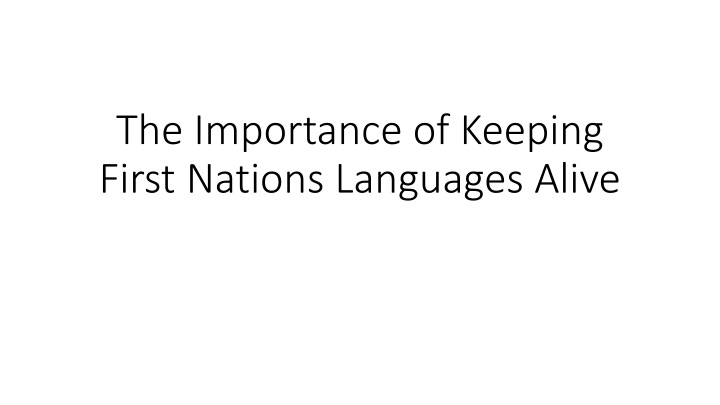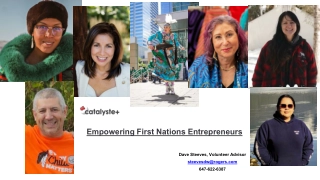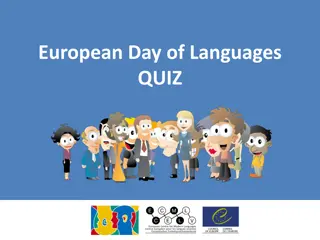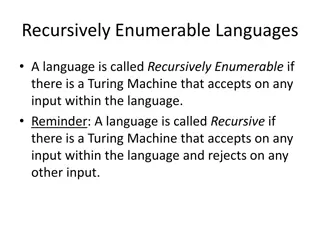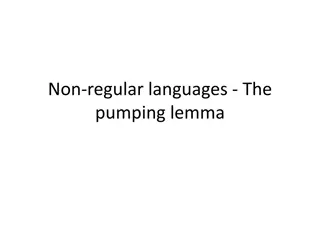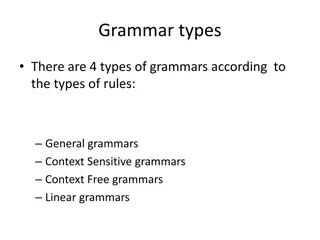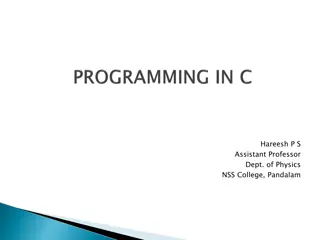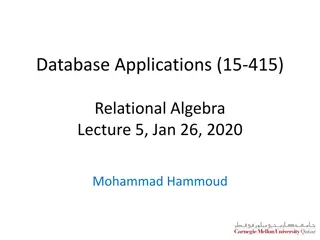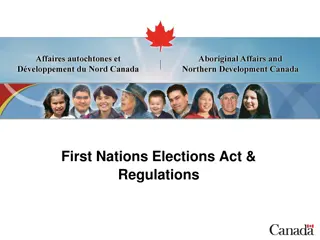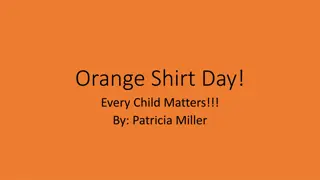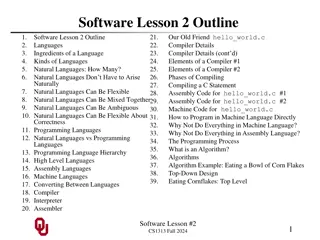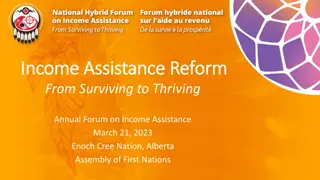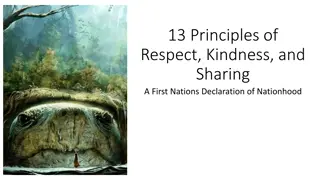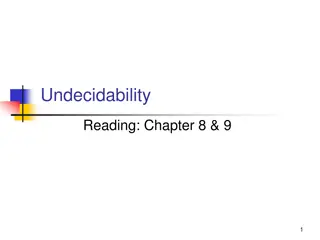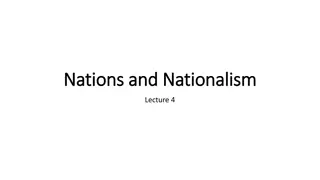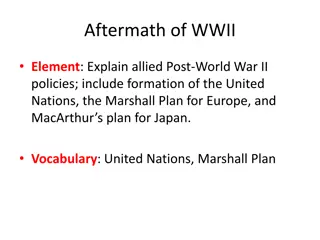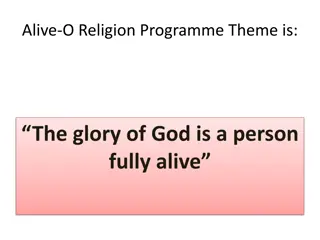Importance of Keeping First Nations Languages Alive
Keeping First Nations languages alive is crucial for preserving cultural heritage, fostering identity, and promoting understanding. Educational initiatives and acknowledging cultural capital play key roles in this endeavor. Explore the significance of language preservation and cultural knowledge integration in education through the TRC Call to Action #62 and insights into the cultural capital of First Nations children. Discover the impact of valuing traditional knowledge and the challenges faced in maintaining linguistic diversity.
Download Presentation

Please find below an Image/Link to download the presentation.
The content on the website is provided AS IS for your information and personal use only. It may not be sold, licensed, or shared on other websites without obtaining consent from the author.If you encounter any issues during the download, it is possible that the publisher has removed the file from their server.
You are allowed to download the files provided on this website for personal or commercial use, subject to the condition that they are used lawfully. All files are the property of their respective owners.
The content on the website is provided AS IS for your information and personal use only. It may not be sold, licensed, or shared on other websites without obtaining consent from the author.
E N D
Presentation Transcript
The Importance of Keeping First Nations Languages Alive
TRC Call to Action #62 Education For Reconciliation: We call upon the federal, provincial, and territorial governments, in collaboration with survivors, Aboriginal peoples, and educators to: i) Make age-appropriate curriculum on residential schools, Treaties, and Aboriginal peoples historical and contemporary contributions to Canada a mandatory education requirement for Kindergarten to Grade Twelve students. ii) Provide the necessary funding to post-secondary institutions to educate teachers on how to integrate Indigenous knowledge and teaching methods into classrooms.
A Cree View of Education For years the education system has devalued the First Nations child s culture as she/he enters the classroom. The First Nations child enters a classrooms that primarily reflect the knowledge and and values of economically and culturally dominant groups, they validate and reinforce what Bordieu called the cultural capitalstudents from such groups bring from home (Nieto 60). The First Nations child is asked to abandon her/his previous learning, his own cultural capital, as she/he enters school. What cultural capital does a First Nations child bring ito the classroom? The graphic below tries to show the cultural capital the FN child brings into the classroom and what happens when she/he begins her/his schooling. Before School A Child s Cultural Capital n cihcik win J t {t 4q!& Hunting and fishing m mawihitowin N nq!{qdq!& Gatherings For years the education system ignored what knowledge a child brings to the classroom. It is time to change that. manahowin nm{aq!& Harvesting tay hk wina Zc L{4q!m Stories aw sis z Z!i * Enter School MATH HISTORY SCIENCE LITERATURE
The cultural capital of a First Nations Child before residential school: Virtues Family History Humour Philosophy Conservation tay hk wina Zc L{4q!m Traditional Stories Berries Firewood Medicice Wild rice Birch syrup manahowin nm{aq!& Harvesting Once a child enters the residential school all the above previous ways of knowing are ignored, devalued and new, foreign systems are introduced as if the child is an empty vessel to be filled. History Literature Powwow Sweats Games Competitions m mawihitowin N nq!{qdq!& Gathering of people Trapping Fishing Hunting Crafts A Child s Culture Capital n cihcik win J t {t 4q!& Hunting, etc. aw sis z Z!i * Child Math Science
THEMATIC UNIT: LANGUAGE AND CULTURE UNIT PLAN1 TOPIC: MONTHS AND SEASONAL ACTIVITIES op wahcikanis sip sim January Blizzard Moon - story telling, beading, round dance, getting wood, square dance, ice fishing, hunting beavers. thithikop wip sim December Hoar Frost Moon - sledding, skating, making sleds, dog sleds (decorate), Christmas! kaskatin wip sim November - Freeze Up Moon - setting traps and snares, story time, beading moccasins, making sleds, making beaded mitts, mukluks. opin skowip sim October Migration Moon - log cabins for winter camp, hunting, snaring, setting snares, log cabins, prepare for winter. n cihitowip sim ohpahowip sim September Rutting Moon - stock pile wood for freeze up, hunting, nakwatisiwin, scrapers, scraping hides, making pemmican, cranberries, choke-cherries. THEME STATEMENT The land and the cycle of the seasons are very special to the Woods Cree; our seasonal activities are dependent on the bounty and generosity of Mother Earth. It is necessary, therefore, to adapt our activities to the cycle of seasons in our school curriculum. kis p sim February Great Moon -storytelling, beading, snow snake, festivals, getting wood, tea in the great outdoors. mikisiwip sim March Eagle Moon - muskrat trapping, king trapper, jigging, story telling (wihtikow) spring preparations. Months and seasonal activities niskip sim April Goose Moon - osk t skwak, pow-wow, tenting, making campfire, birch bark harvest, birch syrup, baskets, The sun s cycle around the earth provided teaching opportunities for the Cree people. Children accompanied the adults as they went about doing what they needed to do to survive. To the right is the English version. ath kip sim May Frog Moon - n t mithihk win, willow whistle, cradle board, paddles, birch bark canoes, tanning hides, herbs, hammock. pin y w wip sim June Egg Laying Moon gathering eggs, strawberries, summer, fish camps, making snowshoes opaskowip sim July Moulting Moon - saskatoons, duck hunting, apw n sk, fry-bread over camp- fire, herbs, loom. August Fly Up Moon - duck hunting, fishing, hunting, scrapers, drums, nam st kwak, drying fish, drying meat, pemmican, blueberries. 1 This theme unit was first developed at the 2000 AILDI for Dr. T. McCarty s materials development class.
ka-pimitisahamahk ma kiskinwahamkwin: nhithowwin ikwa nhithawtisiwin1 k kway: p simawk ikwa ispiht sk wina-pimahkamikisiwin op wahcikanas s kis p sim January Blizzard Moon February Great Moon - cathohk win, m kisihk cik win, cathohk win, m kisihk cik win, - n cacaskw win, p cic win, n cimiht win, s sim ni-m tw win, n wosimon nowin, pakitahw win m ciht winihk win, n cimiht win, cathohk win (wihtikow), n tamiskw win. ta-kis kamisik niwik wathaw timihk. thithikop wip sim December Hoar Frost Moon - s skwaciw win, s niskw tahik win, oc p n skosihk win, -waw s hicik atim- ot p naskwak, makos -k sik w! kaskatinowip sim November - Freeze Up Moon - othast nowina wanihikana ikwa t pakw na, cathohk win, maskisin-m kisihk cik win, osih wak ot p n skosak, m kis- astisihk win, kinwaskisina. pimahamowip sim October Migration Moon - w skahikanisa osiht niwina, m c win, t pakw niwin, piponi-kway cihowin. n cihitowip sim ohpahowip sim opaskowip sim September Rutting Moon August Fly Up Moon - wacimiht win, m c win, - nitawisip niwin, pakitahw win, nakwatisiwin, m tahikana ikwa m cwin, m tahikana m na mihkihwana, matahik niwin, mihkihkwana, mistikwaskihkwak, nam st kwa, k sk wakwa p nis w niwin, akw w niwin. ikwa pimihk n, w sak mina, wiy s m na kinos wak, takwahimina. nitawimin nowin, ithinimina. iyakohci ka-pimitisahamahk ma kiskinwaham k win askiy ikwa k -ispiht sk wik k -kit p htamwak n hithawak k -pap mahkamikisicik ka-pim cihocik; k -itahkamikisiyahk k -ispiht sk wik kahkithaw k kway kim thikosinaw ok w m w askiy. ohcitaw poko kita-n kataw thihtamahk k -isipiht sk wik. mikisiwip sim March Eagle Moon kihci-wanihik sak, n sosimowin, s kwani-kway cihowin. Months and seasonal activities niskip sim April Goose Moon - osk t skwak, pw tisimowin, m nok win, kotaw win, waskway manahowin, s w kamisik win, waskayowatihk win. ath kip sim May Frog Moon -n t mithihk win, n pisiy p t ciakn, tihkin kana, apoyak osih wak, waskway sa osiht niwina, w skwasik niwin, maskiya manahowin, w w pisona. The sun s cycle around the earth provided teaching opportunities for the Cree people. Children accompanied the adults as they went about doing what they needed to do to survive. To the right is the Cree version. opiniy w wip sim June Egg Laying Moon manaw howin, mit himina, ati-n pin, kap sowin, as mihk niwin. July Moulting Moon - mis skat mina, nitawisip win, apw n skohk win, s s piskis pahkw sikan kotaw nihk, maskihkiya manahahowin, m kisihk cikanihk kan. 1This theme unit was first developed at the 2000 AILDI for Dr. T. McCarty s materials development class.
KINSHIP TERMS Here is a kinship chart to try to explain the complexity of the Cree kinship system: MALE nimos m nohkom nohc w s nik w s nisikos nisis noht wiy nik wiy niciw m nitaw m w n st w n tim niya nimis nist s nis mis niciw m nitaw m w FEMALE nimos m nohkom nohc w s nik w s nisikos nisis noht wiy nik wiy niciw miskw m nicahkos niya nimis nist s nis mis niciw miskw m nitaw m w n tim nimos m nohkom nik w s nohc w s nisis nisikos w hk htowin - Kinship n st w n tim nimos m nohkom nik w s nohc w s nisis nisikos nicahkos n tim nitaw m w
CREE KINSHIP: COUSINS and siblings This is how you would talk about your immediate family. Compare the following columns: SOURCE: Children of father s brother or mother s sister: Siblings Children of father s sister or mother s brother (man tisim kanak) nic hkos (also my sister-in-law) nic hkos (also my sister-in-law) nic hkos (also my sister-in-law) n tim (also my brother/sister-in-law) n tim (also my brother/sister-in-law) n tim (also my brother/sister-in-law) n st w (also my brother-in-law) n st w (also my brother-in-law) n st w (also my brother-in-law) n tim (also my brother/sister-in-law) n tim (also my brother/sister-in-law) Female to female niciw miskw m (n tis n) nis mis n tis n Female to younger female Female to older female Female to male / male to female Female to older male nis mis nimis nimis Cousins and Siblings nitaw m w (n tis n) nist s n tis n nist s Female to younger male Male to male nis mis nis mis niciw m (n tis n) nist s n tis n Male to older male nist s Male to younger male nis mis nis mis Male to older female nimis nimis Male to younger female nis mis nis mis
Aunts and uncles: WHO Aunt Mother s sister nik w s (Y) nit sis (TH) Mother s brother nisis also father-in-law Father s sister nisikos also mother-in-law Father s brother nohc w s (Y) nohkomis (TH) WHO Uncle Aunts and uncles
A curriculum toward First Nations Education can be developed based on the organizational chart on Cree ways of knowing below: Cree Ways of Knowing n hithaw kisk thihtamowin Emotional m siht win Spirituality manit w tisowin Physical skills mamaht wisowin Psychological m miton thihcik win Education kiskinoham k win Arts and crafts osihcik win Nature's bounty nitaw thihcik win Storytelling cathohk win Hunting m c win Fishing Gathering man hosowin Trapping wanihik win n cikinos w win Fishing with nets pakitahw win Types of Fish kinos wak Traditional fishing kay sin cikinos w win Angling Preparing Fish osihikinos w win kw skw picik win
